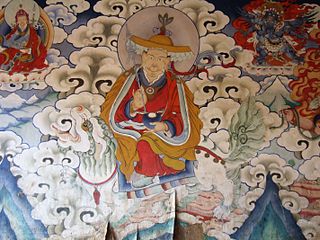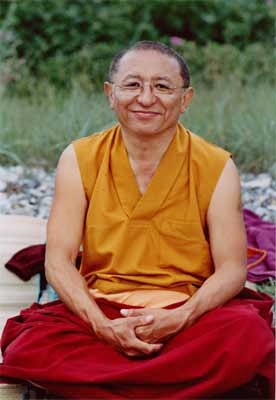
Padmasambhava, also known as Guru Rinpoche and the Lotus from Oḍḍiyāna, was a tantric Buddhist Vajra master from medieval India who taught Vajrayana in Tibet. According to some early Tibetan sources like the Testament of Ba, he came to Tibet in the 8th century and helped construct Samye Monastery, the first Buddhist monastery in Tibet. However, little is known about the actual historical figure other than his ties to Vajrayana and Indian Buddhism.

Jamgön Kongtrül Lodrö Thayé, also known as Jamgön Kongtrül the Great, was a Tibetan Buddhist scholar, poet, artist, physician, tertön and polymath. He was one of the most prominent Tibetan Buddhists of the 19th century and he is credited as one of the founders of the Rimé movement (non-sectarian), compiling what is known as the "Five Great Treasuries". He achieved great renown as a scholar and writer, especially among the Nyingma and Kagyu lineages and composed over 90 volumes of Buddhist writing, including his magnum opus, The Treasury of Knowledge.
Tsele Natsok Rangdröl (1608-?) was an important master of the Kagyü and Nyingma schools of Tibetan Buddhism. He is also known as Tsele Gotsangpa.
Mañjuśrīmitra was an Indian Buddhist scholar. He became the main student of Garab Dorje and a teacher of Dzogchen.
Sri Singha was the teacher of Padmasambhava, Vimalamitra, and Vairotsana. He was a principal student and dharma-son of Mañjuśrīmitra in the Dzogchen lineage, and is credited by the Nyingma school with introducing Dzogchen to Tibet.
According to the Nyingmapa tradition of Tibetan Buddhism, the Dzogchen masters Manjushrimitra and Shrisimha were already active in the Tantric milieu in India independently. However, Manjushrimitra, a learned scholar of Brahman origin, was evidently an adherent of the Yogachara school before his becoming a disciple of the mysterious Prahevajra or Garab Dorje from the country of Uddiyana. It should also be recalled that his disciple Shrisimha was said to have born and resided for some time in China before coming to India. And that the latter's disciple Vimalamitra visited China before and after he came to Tibet and transmitted the Dzogchen teachings to his disciples at Samye Monastery.

Torma are sculptures made mostly of flour and butter used in tantric rituals or as offerings in Tibetan Buddhism. They may be dyed in different colors, often with white or red for the main body of the torma. They are made in specific shapes based on their purpose, usually conical in form. A very large, central shrine torma may be constructed for festivals, though typically they are small and placed directly on a shrine, on a plate, mounted on leather or held on a special base like a skull.

Gyalpo spirits are one of the eight classes of haughty gods and spirits in Tibetan mythology and religion. Gyalpo, a word which simply means "king" in the Tibetic languages, in Tibetan mythology is used to refer to the Four Heavenly Kings and especially to a class of spirits, both Buddhist and Bon, who may be either malevolent spirits or oath-bound as dharmapalas.

Chökyi Nyima Rinpoche is a Tibetan Buddhist teacher and meditation master. He is the abbot of Ka-Nying Shedrub Ling Monastery in Kathmandu, Nepal. He is the author of several books, founder of meditation centers around the world, and an international teacher.
Cetanā is a Buddhist term commonly translated as "volition", "intention", "directionality", etc. It can be defined as a mental factor that moves or urges the mind in a particular direction, toward a specific object or goal. Cetanā is identified within the Buddhist teachings as follows:
Manasikara is a Buddhist term that is translated as "attention" or "mental advertence". It is defined as the process of the mind fixating upon an object. Manasikara is identified within the Buddhist Abhidharma teachings as follows:
Adhimoksha is a Buddhist term that is translated as "interest", "intensified interest", or "decision". It is defined as holding onto a certain form object; its function is not to lose the object.

Hri is a Buddhist term translated as "self-respect" or "conscientiousness". It is defined as the attitude of taking earnest care with regard to one's actions and refraining from non-virtuous actions. It is one of the virtuous mental factors within the Abhidharma teachings.
Apatrapya is a Buddhist term translated as "decorum" or "shame". It is defined as shunning unwholesome actions so as to not be reproached by others of good character. It is one of the virtuous mental factors within the Abhidharma teachings.
Alobha is a Buddhist term translated as "non-attachment" or "non-greed". It is defined as the absence of attachment or desire towards worldly things or worldly existence. It causes one to not engage in unwholesome actions. It is one of the virtuous mental factors within the Abhidharma teachings.
Prasrabhi is a Mahayana Buddhist term translated as "pliancy", "flexibility", or "alertness". It is defined as the ability to apply body and mind towards virtuous activity. Prasrabhi is identified as:
Āśraddhya is a Buddhist term that is translated as "lack of faith", "lack of trust", etc. In the Mahayana tradition, āśraddhya is defined as a mental factor that is characterized by a lack of trust, and lack of interest in, or desire for, wholesome things.
The Rangjung Yeshe Wiki is a Wiki community established in 2005 focused on building a Tibetan-English Dictionary, glossaries of Buddhist terminology, biographies of Buddhist teachers, and articles on important Tibetan Buddhist literary works and collections. The site aims to develop resources useful for the "community of lotsawas" involved in translating Buddhist texts from Classical Tibetan to English and other European Languages. The original content of the Wiki was based on a digital Tibetan-English dictionary compiled by the translator Erik Pema Kunsang in the early 1970s. The Rangjung Yeshe Wiki currently has over 23,720 articles, 1,060 uploaded files, and 825 registered users. The site is hosted and supported by the Tsadra Foundation. The Dharma Dictionary features the Tibetan words of renowned Tibetan translators such as Erik Pema Kunsang (including the complete Rangjung Yeshe Tibetan-English dictionary of Buddhist Culture, Ives Waldo, Jim Valby, Richard Barron, Gyurme Dorje, Thomas Doctor, Matthieu Ricard and more.

Phakchok Rinpoche is a teacher of the Nyingma lineage and chief lineage holder of the Taklung Kagyu lineage of Tibetan Buddhism. He is Vajra Master of Ka-Nying Shedrup Ling monastery, abbot of several monasteries in Nepal, and assists monasteries and practice centers in Tibet. In addition, he serves as Director of the Chokgyur Lingpa Foundation, a nonprofit organization engaged in a wide range of humanitarian projects.
Tsikey Chokling Rinpoche was a teacher, writer, religious ritual master, and meditation master of the Nyingma school of Tibetan Buddhism.

In Dzogchen, the view is one of the Three Dharmas of the Path of Dzogchen. The other two dharmas of the path are practice (gompa) and conduct (chöpa).








